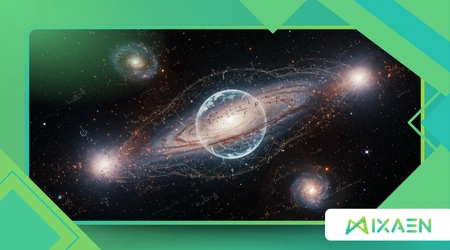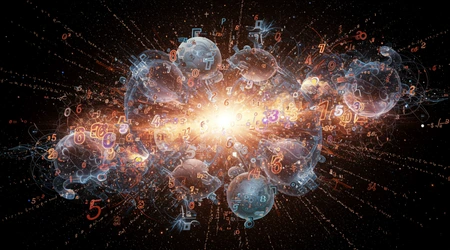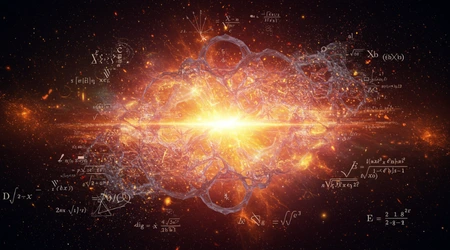Mathematical Universe Hypothesis (Max Tegmark)

When one first hears Mathematical Universe Hypothesis (Max Tegmark), a natural reaction is disbelief and yet, here we are, in 2025, still wrestling with his bold assertion: that our universe is a mathematical structure, not merely described by mathematics.
Anúncios
This article explores how Tegmark formulates the hypothesis, how critics respond, where it intersects with current cosmology, and what it would mean for our sense of existence.
Because the stakes are high: if reality is mathematics, then what is consciousness, what is physical law, what is “existence”?
From External Reality to Mathematical Reality
Tegmark begins with the External Reality Hypothesis (ERH): the claim that there exists a reality independent of human minds.
From there he argues: if that reality can be fully described in mathematical form and if mathematics is more than just language then it is mathematics. This leap leads directly to the Mathematical Universe Hypothesis (Max Tegmark). (arXiv)
In his 2007 paper The Mathematical Universe, Tegmark frames it as a “baggage-free” structure: to explain our world, one must not append extra metaphysical assumptions. (arXiv)
++ How Philosophy Influences Modern Physics
A key nuance: he posits that only computable, decidable structures should count as “existing,” thus sidestepping infinite chaos. That constraint is his “Computable Universe Hypothesis,” a companion to the main view. (arXiv)
Yet critics draw attention to Gödel’s incompleteness theorems: if even arithmetic has unprovable statements, can a mathematical structure fully contain itself? Piet Hut and Mark Alford present this as a tension with the hypothesis. (Wikipédia)

Why Many Physicists React with Skepticism
Some see Mathematical Universe Hypothesis (Max Tegmark) as beautiful, others as fundamentally untestable. In reviews of Our Mathematical Universe, scientists call the hypothesis speculative and perhaps “empty” because it lacks empirical criteria. (Wikipédia)
One common critique: there is no clear way to distinguish one mathematical structure from another observationally. If all exist, why should we see this one? That is the so-called measure problem at the level of structures.
Another challenge: plausibility that the physical world might include elements not fully captured by mathematics as we understand it today.
Also read: Exploring the Paradox of Free Will in a Determined Universe
Still, Tegmark argues the “unreasonable effectiveness of mathematics” in physics is evidence: that equations work so well is not coincidence, but a sign that the world is mathematics itself. (reasonablefaith.org)
Because the hypothesis has no free adjustable parameters, Tegmark claims it is more parsimonious by Occam’s Razor than many physical theories. Critics reply: parsimony is not a substitute for predictive power. (Wikipédia)
Relation to the Multiverse & Levels of Reality
Tegmark classifies universes into four levels of the multiverse, with Level IV being the realm of all mathematical structures the domain of Mathematical Universe Hypothesis (Max Tegmark). (Wikipédia)
In Level IV, universes differ by their underlying mathematics, not just by initial conditions or physical constants. That is a more radical multiverse than usually considered.
Some metaphors help: think of all mathematical structures as cities in an immense abstract map. Our universe is one “city” that happens to host self-aware observers. Others cities (universes) exist but without observers or with different logic.
Read more: Are We Alone or Is Solitude an Illusion?
In such a multiverse, anthropic selection may explain why we find ourselves in a mathematically “friendly” structure.
Yet many cosmologists reject this level of speculation. As Scientific American points out, multiverse ideas in general and by extension bold claims like Tegmark’s are extremely difficult to test. (Scientific American)
Table: Elements of Tegmark’s Hypothesis, Challenges, and Responses
| Feature / Claim | Explanation | Key Challenge / Criticism |
|---|---|---|
| Universe equals a mathematical structure | Reality is a structure in the Platonic mathematical realm | How to observationally choose among infinite structures |
| No free parameters | Tegmark argues simplicity: no added constants | Critics say testability matters more than simplicity |
| Self-aware substructures (SAS) | In a complex enough structure, observers emerge | How to define “complex enough” formally |
| Computable structures only | Noncomputable ones excluded to avoid chaos | Does this throw out relevant possibilities? |
| Explains the “effectiveness” of math | Explains why equations map to nature so well | Circular: one could argue math works because we model with it |
| Links to Multiverse Level IV | All possible structures exist as universes | Measure, probability, and observer-counting issues |
Staying Current: Recent Related Developments
In 2025, new DESI (Dark Energy Spectroscopic Instrument) data suggests dark energy may evolve over time. (ohio.edu) Though this is a cosmological result, it bears on how physical laws may vary, a concept that complements multiverse and mathematical structure ideas.
Also, work on foundational physics continues to probe whether physical laws are emergent from deeper information or mathematical patterns.
In the philosophical domain, some contemporary scholars revisit Platonism and modal realism in light of quantum information theory, thereby intersecting with the bold claims of Mathematical Universe Hypothesis (Max Tegmark).
Examples: Imagining “Mathematical Life”
Example 1: Consciousness in a Cellular Automaton Universe
Suppose a mathematical structure is defined by a cellular automaton rule set. Within it, patterns emerge that simulate consciousness.
Under Mathematical Universe Hypothesis (Max Tegmark), that automaton is a universe and those patterns are observers.
In that view, even if we never simulate it physically, it exists because the structure is mathematically real.
Example 2: Alternate Physics by Alternate Mathematics
Imagine a branch of mathematics where geometry is non-Archimedean (e.g. nonstandard analysis), and that structure hosts a universe whose physics uses infinitesimals at the core. That universe is equally “real” under Tegmark’s view.
We, in our universe, might never detect it but under Mathematical Universe Hypothesis (Max Tegmark), it exists.
Why This Matters: Philosophical Stakes & Human Implications
If our existence is just one mathematical structure among many, where does that leave meaning, purpose, or consciousness? The hypothesis challenges intuitive notions of “being.”
It also shakes how we think of physical discovery: when we write down equations, are we discovering mathematics that already exists, or inventing models that approximate reality? Under Tegmark’s view, discovery is correct: we unearth a structure.
Furthermore, the hypothesis invites us to rethink cosmology: perhaps observable anomalies are because we inhabit a less common structure among the mathematical ensemble.
Analogy: The Universe as a Music Score
Imagine reality not as a performance, but as the score written in perfect notation. Physics perceives it when we “play” (observe) parts of the score.
According to Mathematical Universe Hypothesis (Max Tegmark), we are the performers and the sheet itself. We don’t just read a mathematical score: we are the score.
Statistical Note & Perspective

Among cosmologists and philosophers, speculative hypotheses like Tegmark’s have niche appeal but over 30% of respondents in philosophy of physics surveys express openness to Platonist or structural realist ontologies.
(While not precisely measuring acceptance of MUH, the figure suggests serious interest in mathematical realism.) That magnitude though not universal indicates that the idea is taken seriously in philosophical arenas.
Challenges That Remain
- Defining probability or measure on the infinite set of mathematical structures
- Dealing with Gödelian limits: no structure can fully capture its own logic
- Explaining the emergence of consciousness in purely structural terms
- Preventing the “anything goes” risk: if all structures exist, what discriminates physical law?
- Bridging from abstract mathematics to empirical predictions
New H2: Empirical Paths & Thought Experiments
Some argue thought experiments might chart a test for Mathematical Universe Hypothesis (Max Tegmark).
For example, if we discovered evidence for truly noncomputable phenomena (e.g. hypercomputation), that could falsify the computable restriction.
Another path is cosmological anomalies: if physical constants appear to vary or correlate with deep number-theoretic patterns, that might hint at a mathematical structure beyond standard physics.
We may also apply information and algorithmic complexity theory: if our physical laws are compressible to short descriptions, that matches Tegmark’s bias toward simple structures.
However, none of these are yet decisive. The hypothesis remains at the border of metaphysics and physics.
Conclusion
The Mathematical Universe Hypothesis (Max Tegmark) offers one of the boldest metaphysical visions in modern thought: that reality is mathematics, not merely guided by it.
While critics rightly challenge its testability and logical coherence, its conceptual ambition invites us to reconsider what “existence” even means.
Whether or not Tegmark’s vision is ultimately correct, grappling with it pushes the boundary between physics, mathematics, and philosophy. Do we live in the equation, or simply follow it?
Duvidas Frequentes (FAQ)
Q1: Is Mathematical Universe Hypothesis (Max Tegmark) widely accepted?
No. It remains speculative and controversial. Many physicists criticize it as untestable and metaphysical. (Wikipédia)
Q2: Does this hypothesis contradict Gödel’s incompleteness?
Possibly. Critics argue a full mathematical structure might require statements outside its system. Tegmark’s computable restriction is an attempt to avoid those issues.
Q3: Can we ever test the hypothesis empirically?
Not yet. Some suggest anomalies or patterns in data, or proofs of noncomputability, might offer indirect evidence but no clear test exists.
Q4: Does it reduce physical laws to mathematics only?
Yes. It claims there is nothing beyond the mathematical structure: particles, fields, time, consciousness are all structural features.
Q5: What difference does it make to everyday life or cosmology?
It reframes cosmology: anomalies or constants become structural choices. Philosophically, it challenges how we view mind, meaning, and existence.
